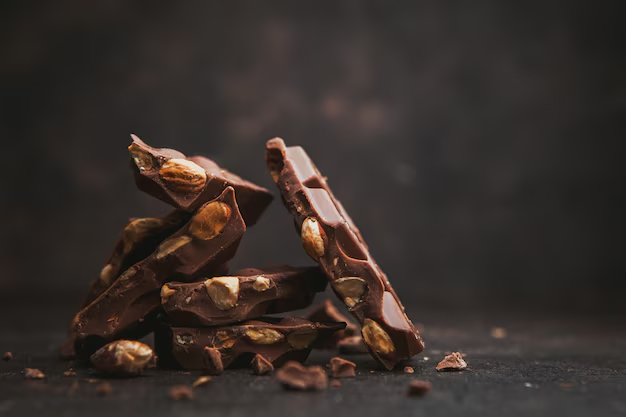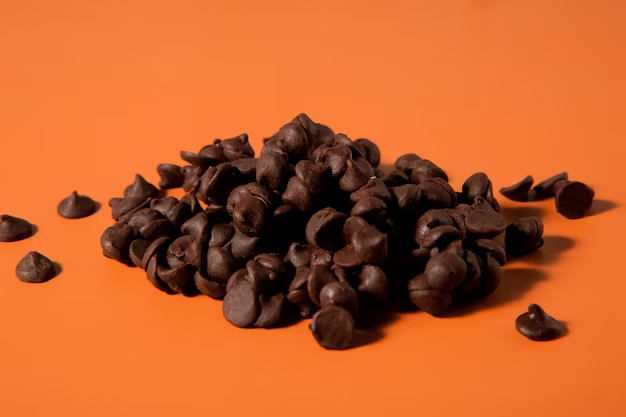Dark chocolate is a beloved treat, known for its rich taste and potential health benefits. It has gained immense popularity across the U.S., not just for its flavor but also for its reputation as a healthier chocolate option. Yet, many wonder, does dark chocolate have caffeine? The short answer is yes, but the levels can vary depending on the type and brand.
Terms like caffeine content in chocolate or dark chocolate caffeine levels are commonly searched as people explore how this treat compares to other caffeinated products. Let’s dive deeper to uncover what makes dark chocolate unique and how much caffeine it really contains.
What Is Dark Chocolate?
Dark chocolate is a type of chocolate with a higher cocoa content compared to milk or white chocolate. Its rich flavor and darker color come from the cocoa solids, which form its base. Unlike milk chocolate, which contains more sugar and milk solids, dark chocolate focuses on simplicity with three main ingredients: cocoa solids, cocoa butter, and sugar.
Difference Between Dark, Milk, and White Chocolate
The primary difference lies in the cocoa content:
- Dark chocolate: High cocoa content (50–90%), minimal sugar, no milk solids.
- Milk chocolate: Contains cocoa solids (10–50%), sugar, and milk.
- White chocolate: Made from cocoa butter, sugar, and milk, with no cocoa solids.
Dark chocolate is the least sweet and has a more robust flavor, making it a favorite among health-conscious consumers.
How Is Dark Chocolate Made?
The journey of dark chocolate begins with cocoa beans, harvested from cacao trees. Here’s the process:
- Fermentation and drying: Fresh cocoa beans are fermented to develop flavor, then dried.
- Roasting: Beans are roasted to bring out their rich, chocolatey taste.
- Grinding and processing: The beans are ground into a paste called cocoa liquor, which contains cocoa solids and cocoa butter.
- Mixing and refining: The cocoa liquor is mixed with sugar and other ingredients.
- Molding and cooling: The mixture is molded into bars and cooled.
This manufacturing process, along with the percentage of cocoa solids, directly affects the caffeine levels in the final product.
The Caffeine Content

Does Dark Chocolate Contain Caffeine?
Yes, dark chocolate contains caffeine. This is because caffeine is naturally found in cocoa beans. The more cocoa in the chocolate, the higher the caffeine content.
How Much Caffeine Is in Dark Chocolate?
The amount of caffeine in dark chocolate varies based on its cocoa percentage. Higher cocoa percentages mean more caffeine. Here’s a breakdown:
- 70–85% cocoa: ~80 mg caffeine per 100 grams.
- 45–59% cocoa: ~43 mg caffeine per 100 grams.
- Milk chocolate (10–20% cocoa): ~20 mg caffeine per 100 grams.
- White chocolate: Almost no caffeine, as it contains no cocoa solids.
For comparison:
- A cup of brewed coffee contains 95–200 mg of caffeine.
- A can of cola has about 35 mg of caffeine.
So while dark chocolate has less caffeine than coffee, consuming large amounts can still contribute to your daily intake.
Factors Affecting Caffeine Levels
Cocoa Percentage: The Higher, the Stronger
The caffeine content is directly linked to the percentage of cocoa in the chocolate. For instance:
- A 90% cocoa dark chocolate bar will have significantly more caffeine than a 50% bar.
- Milk and white chocolates, with less cocoa, have minimal to no caffeine.
Brand Variations
Different brands produce chocolates with varying caffeine levels due to their unique recipes and cocoa sourcing practices. Examples include:
- Ghirardelli Intense Dark (86%): Approximately 86 mg caffeine per 40 grams.
- Lindt Excellence (85%): Around 80 mg caffeine per 40 grams.
- Hershey’s Special Dark (45%): Roughly 20 mg caffeine per 40 grams.
Serving Size and Packaging
The serving size also plays a big role. A larger bar or a higher serving portion will naturally increase caffeine intake. Some brands offer individually wrapped pieces, making it easier to control consumption.
Health Implications
Dark chocolate is a beloved treat that combines rich flavor with potential health benefits. However, like coffee, dark chocolate contains caffeine, and understanding its effects can help consumers make informed choices. This article will explore the health benefits, potential downsides, and essential insights into caffeine levels, especially for sensitive groups and comparisons between dark and milk chocolate.
Benefits of Caffeine in Dark Chocolate
Caffeine, naturally found in cocoa beans, offers various advantages when consumed in moderation. The dark chocolate benefits include:
Enhanced Alertness and Improved Focus
Caffeine is a well-known stimulant that can help boost mental alertness, increase focus, and improve cognitive performance. A moderate intake of caffeine from dark chocolate can provide an energy boost during midday slumps or when staying mentally sharp is essential.
Rich Source of Antioxidants
Dark chocolate is packed with flavanols—powerful antioxidants that can offer numerous health benefits. Flavanols can combat oxidative stress in the body, support heart health, and lower the risk of chronic diseases by reducing inflammation.
Antioxidants found in dark chocolate have been linked to improved cardiovascular health, better blood flow, and even cognitive function. These benefits, combined with caffeine, make dark chocolate a unique and nutritious treat.
Potential Downsides
While moderate caffeine consumption has benefits, excessive intake can lead to certain drawbacks. Some common concerns include:
Jitters and Anxiety
Too much caffeine can lead to feelings of restlessness, nervousness, and jitters. Individuals sensitive to caffeine should monitor their consumption carefully.
Sleep Disruption
Caffeine blocks adenosine, a neurotransmitter responsible for sleep regulation. Therefore, consuming dark chocolate late in the day could interfere with sleep quality.
Caffeine Sensitivity
Some individuals are more sensitive to caffeine than others, with even small amounts causing adverse effects like headaches or increased heart rate.
Who Should Monitor Caffeine in Dark Chocolate?
Understanding the effects of caffeine is especially critical for certain groups of people. Monitoring caffeine intake is recommended for the following groups:
Sensitive Groups
- Pregnant Women: Caffeine intake during pregnancy should be limited to ensure fetal health.
- Children: Excessive caffeine can affect a child’s growth and development.
- Individuals with Heart Conditions: High caffeine intake can worsen heart palpitations or increase blood pressure.
Recommended Daily Caffeine Limits
The general recommendation for safe daily caffeine consumption is 200-400 mg for most adults. However, caffeine from other dietary sources like tea, coffee, or sodas should also be factored into this total.
Comparing Caffeine in Dark and Milk Chocolate
The caffeine content in chocolate can vary depending on its type. Let’s break it down:
Which Has More Caffeine?
Dark chocolate contains significantly more caffeine than milk or white chocolate because of its higher cocoa content. For comparison:
- Dark Chocolate: Contains 50-70% cocoa, with approximately 70-100 mg of caffeine per 1 oz.
- Milk Chocolate: Contains 20-40% cocoa, with 20-30 mg of caffeine per 1 oz.
- White Chocolate: Generally contains little to no caffeine due to the absence of cocoa solids.
Why Does Milk Chocolate Have Less?
Milk chocolate has lower cocoa content and higher milk solids, which directly reduce its caffeine levels. This makes it a milder alternative for those monitoring their caffeine intake.
Tips for Choosing Low-Caffeine Chocolate Options
If you’re sensitive to caffeine or aiming to reduce its intake, here are some helpful tips:

How to Read Labels for Cocoa Content
Look at the cocoa percentage on chocolate labels. The higher the percentage, the more caffeine the chocolate is likely to contain. Opt for dark chocolate with lower percentages if you want to manage caffeine intake.
Alternative Low-Caffeine Treats
- White Chocolate: Lacks cocoa solids, making it a great choice for those avoiding caffeine.
- Chocolate-Free Desserts: Consider other alternatives like fruit-based or vanilla-flavored sweets.
FAQs
Does all chocolate have caffeine?
Yes, all types of chocolate—dark, milk, and even white—contain some level of caffeine, although the amounts vary. Dark chocolate has the highest caffeine content due to higher cocoa solids.
How does caffeine in chocolate compare to tea or coffee?
Caffeine levels in dark chocolate are generally lower than those in a cup of coffee but can be higher than that in tea. For example, one cup of coffee contains around 95 mg of caffeine, while dark chocolate has about 70-100 mg per ounce.
Can caffeine in chocolate disrupt sleep?
Yes, consuming dark chocolate late in the day may interfere with sleep quality due to caffeine’s ability to block the sleep-promoting effects of adenosine.
Conclusion
Dark chocolate is a flavorful and beneficial treat with antioxidant properties and the stimulating effects of caffeine. While it has proven health benefits, it’s important to monitor caffeine intake, especially for individuals sensitive to its effects.
Enjoy dark chocolate in moderation and be mindful of its caffeine content to experience its health benefits without any unwanted side effects.


